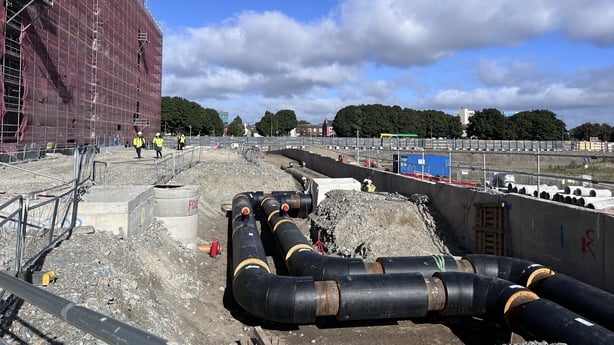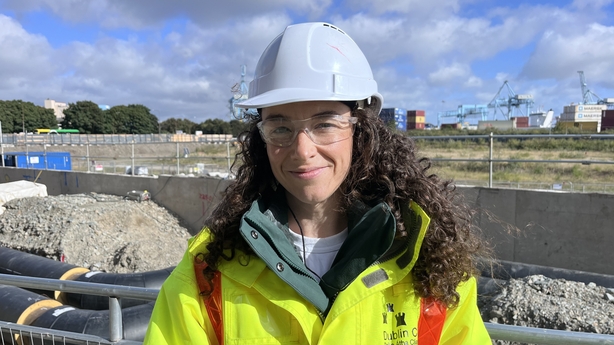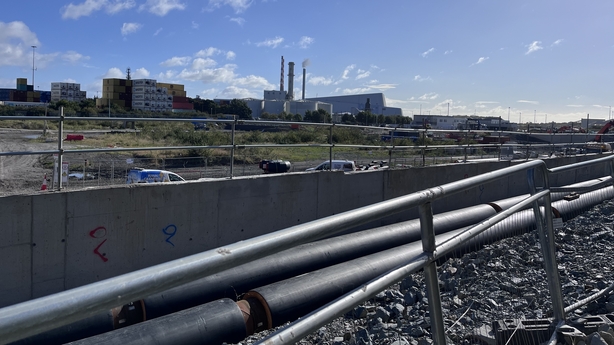Dublin’s Energy Agency has called for more funding to be committed to develop district heating in the capital.
The system, which uses excess heat produced by industry to heat homes and businesses was first rolled out in Tallaght in south Dublin almost eighteen months ago.
But Codema, who work with local authorities in the capital to promote energy efficiency, say opportunities to develop the system could be lost if this Government does not provide more supports for the sustainable heating model.
They were speaking during Dublin Climate Week which runs until 15 September.
Back in April 2023, two buildings – South Dublin County Council’s headquarters in Tallaght and the main campus of TU Tallaght – became the first to be heated using excess heat from a nearby Amazon data centre.
Since then two more buildings have been added to the district heating system, including the Work IQ Innovation Centre in Tallaght, which is South Dublin County Council’s hub for start-up companies and enterprise.
A new apartment development is next to be added to the system, which will continue to expand to other parts of the community
Therese Pender, Senior Architect, South Dublin County Council says there have been multiple benefits from the project.
“Eighteen months in we’re saving 1,500 tons of carbon a year. That’s 10% of our target for Tallaght for 2030.
“But the biggest advantage really is that we’ve done it, we’ve proven the concept that district heating with waste heat from a data center can work.
“We have continued operations through all our seasons, for all our customers, without without any major issues. I think there’s a great sense of local pride in the project, and generally it’s a great example for other projects”
The plan is to expand the use of this locally produced heat to other parts of the community in the coming years.
“The fact that there’s no chimney on this centre is actually the really important trick here.
“We’re not burning anything. What we’re doing is we’re taking waste heat.
“Every degree centigrade of heat that we take, we generate three, with very sustainable heat pumps and then we’re distributing it.
“So we’re not relying on imported fossil fuels. Geopolitically, we have come through a turbulent time. This allows us to be independent in our heat sources.
“We have 133 cost rental apartments that are connecting by the end of this year, that will be our first residential project and a new university building.
“After that, we have an expansion plan over the next three to five years to connect another up to 3,500 apartments.

“So we’re growing and we’re looking to the future as to where we expand. Ideally, we’ll expand into Cookstown.
“It’s where Tallaght village town is going to extend, where the council envisages up to 11,000 new homes over the coming period.”
The next big district heating project planned for the capital is in Ringsend where they’ll take excess heat from the Waste to Energy plant in Poolbeg to heat almost 4,000 homes and multiple commercial units at the Glass Bottle site before continuing on to premises in the north and south docks.
Work is currently underway at the site to lay the pipes which will bring the heat to one of Dublin’s newest housing and commercial quarters, that will eventually have 20,000 people living and working there.
But the agency that works with Dublin’s local authorities to promote energy efficiency says more needs to be done to develop district heating in the capital.

Donna Gartland, CEO, Codema the Dublin Energy Agency explains how the Ringsend system will work
“There’s a huge amount of waste heat that’s at the moment, being either thrown into the sky, through the chimney stacks there, or into the River Liffey.
“So instead of throwing that away, we’re going to basically reroute that through large pipes, firstly to the Irish Glass Bottle site and then onwards into the city to the north of south docklands areas where we can provide heat for hundreds more buildings.
“District heating is a well established, well used technology.
“It’s used across Europe in hundreds of cities and towns and it’s around for over 100 years.
“In Ireland, we’re just kind of playing catch up at the moment.
“And one of the real benefits is, particularly for Ireland, that we have lots of indigenous sources of renewable heat and waste heat, so such as the waste energy plant in Ringsend, that we can utilise to replace all the fossil fuels, gas and oil, that we’re using for heat.

“We actually have enough resources here to replace all those imported fuels.
“The war in Ukraine showed us how escalating prices can really affect a consumer.
“For example, in Denmark, during that same period, the customers there who were on district heating networks, 90% of them either felt no change in their prices or a lower price for heat because there was applied through district heating networks.
“There’s a real sense of urgency now, because there are projects that are in planning. They’re waiting to go.
“They have customers ready to take district heating, but there’s no supports at the moment.
“The last supports that were available directly for district heating were in 2018.
“Since then, there’s been lots of projects planned, but there’s no clear market signal there from the government to say, look, these are the supports that are coming down the line.
“That needs to happen within this government term.
“We’ve had a lot of support from the current Government, particularly from the Green Party.
“There’s been a lot of movement in the last four years, but there’s a sense of urgency now, otherwise all these opportunities are going to be lost.”
